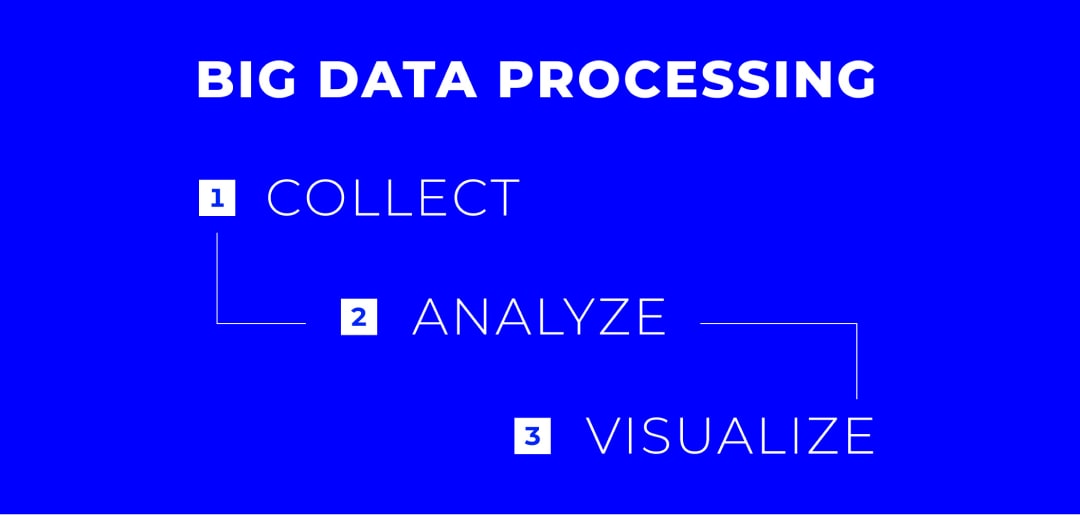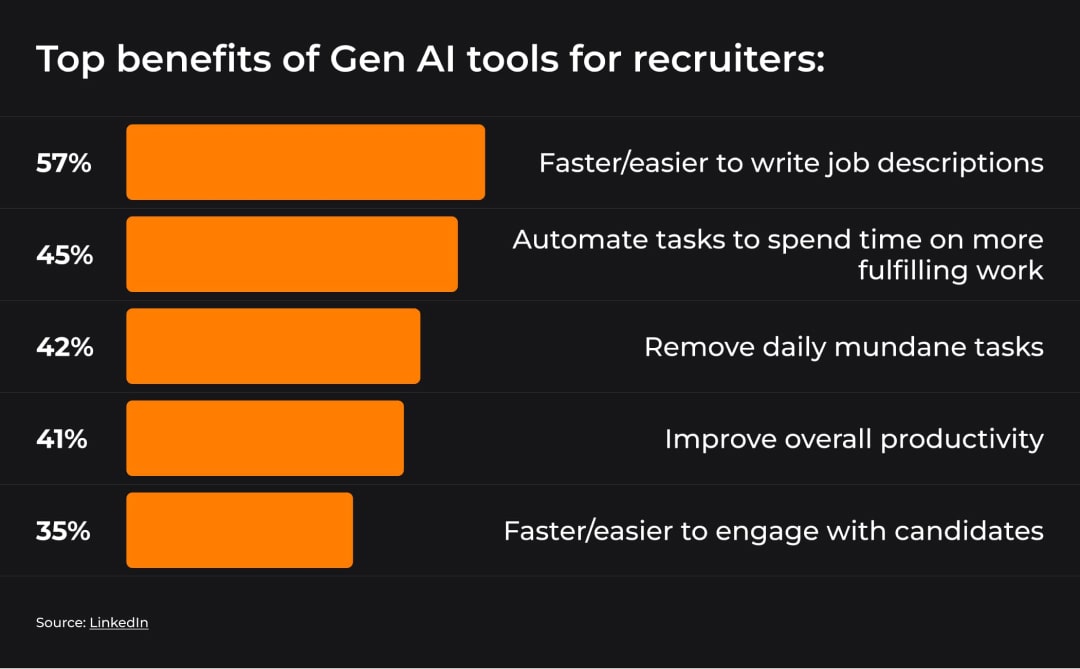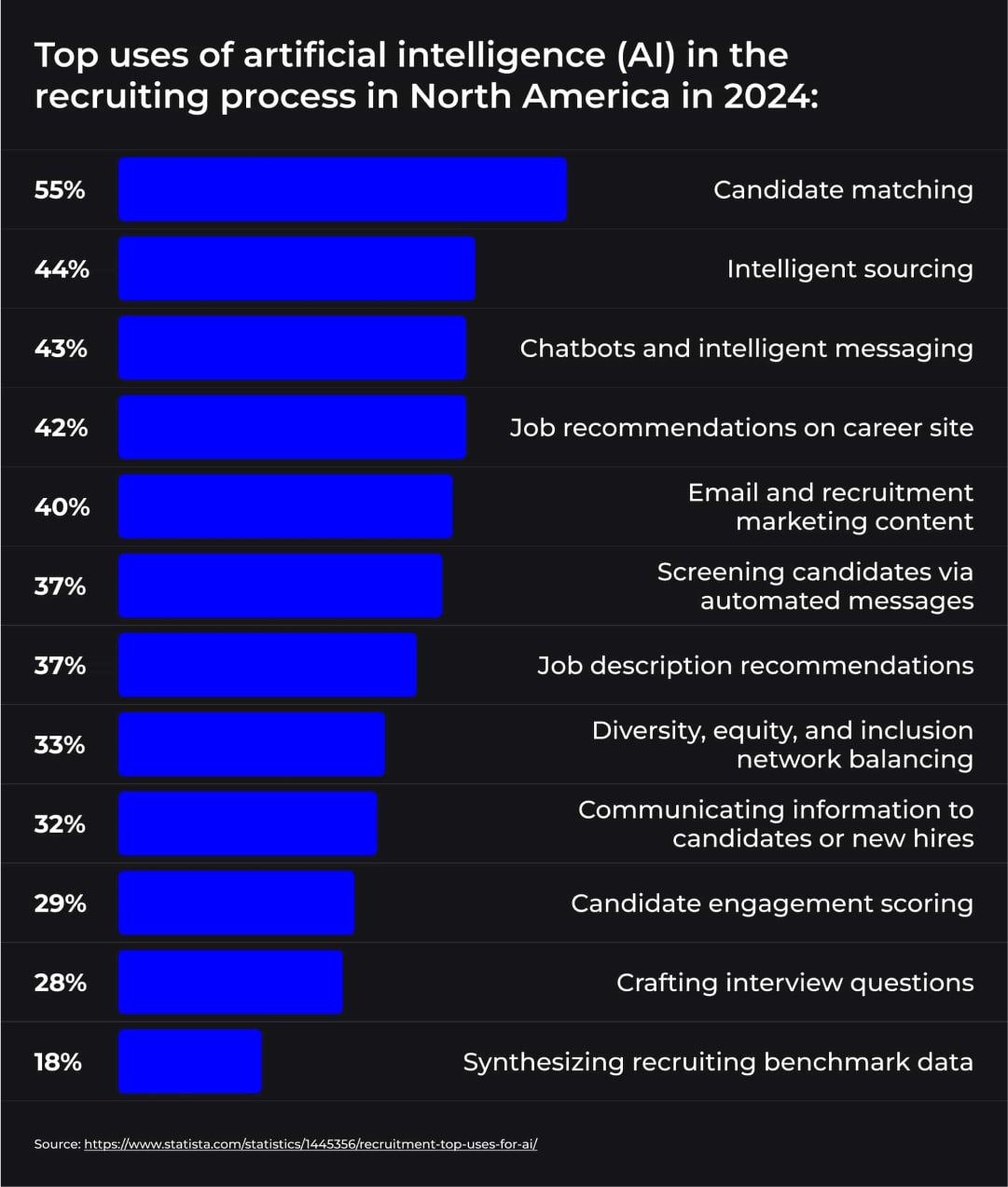Traditional methods of hiring, which relied heavily on resumes, interviews, human analytics, and gut feelings, are now being revolutionized by the power of big data.
Yet, the using of big data for recruiting within IT companies involves increasing budget sizes if you implement advanced AI tools. We'll explore the plus factors of big data for recruiting and answer whether its impact on the hiring process is worth urgent investments.
What is Big Data in Recruitment?
Big data recruitment is the practice, which helps process big amounts of data, which later help with hiring decisions. Sophisticated algorithms and artificial intelligence (AI) collect data to identify patterns and trends “invisible” to human recruiters and help companies find ideal employees.

Sources of Big Data for Recruiters
Where should we look for the numbers and facts necessary to foster big data & analytics recruitment in tech companies? Let’s observe the available data landscape.
External Sources
Job boards & Social media
Data from social media profiles and job boards showcases employment histories of potential candidates, their professional network, interests, and industry engagement.
Market & Industry Trends
Understanding market and industry trends (like hourly rates for the role you want to fill) can help you make informed decisions about hiring strategies and talent acquisition approaches. That’s why it’s crucial to monitor industry reports, economic indicators, and government labor statistics to anticipate changes in the tech talent market.
Competitor Analysis
Analyzing data about your competitors' hiring practices and talent pools can help you identify opportunities and areas for improvement in their recruitment strategies.
CRM & ERP
Big data for recruiters includes some types of data from your CRM and ERP systems form business objectives for new hires.
Sales Data
By tracking the sales growth, you can be more precise in estimating your team-scaling needs.
Delivery data
If your plans (to finish the app update till the agreed date, for instance) tend to differ from reality, you may need to fill some skill gaps in your team to align with deadlines.
ATS
An ATS (Applicant Tracking System) is one of the best recruiting tools available, organizing a wealth of data on candidate interactions, interview feedback, and recruitment stages. ATS often includes reporting and analytics features.
Resumes and Applications Data
This structured data from resumes, cover letters, and job applications can help identify relevant skills, qualifications, and experience from a large pool of candidates.
Assessment and Testing Data
Data from pre-employment assessments and skills tests, like live coding sessions, can be valuable for predicting a candidate's potential success within a tech company.
Candidate Feedback Data
Collecting feedback from candidates who have gone through the hiring process can provide valuable insights into the candidate experience, allowing you to make improvements.
HRIS
HRIS, or Human Resources Information System, works similarly to ATS, but it contains the data about existing team members. By studying HRIS data, you can attract better candidates.
Performance Tracking
Existing team performance data is a source of information necessary to identify patterns and traits associated with successful hires.
Compensation & Benefit
You can decide on rates and describe possible benefits and compensation growth for new developers or other tech specialists, taking into account your current compensation programs for similar roles.
Learning Progress
You can determine the most promising candidates for new team roles inside your company. Check if some of your hires have demonstrated they can easily acquire new skills!
Exit Interviews
By studying the scores of exit interviews, you learn why specialists leave and can prevent those scenarios in the future.
A good idea is to integrate your HRIS with ATS, CRM, external sources, and data visualization tools like Tableau, Power BI, and QlikView. Such tools allow users to create interactive dashboards and various reports that highlight, for example, results of tracking key performance indicators (KPIs).
How Big Data Recruiting Changes Hiring?
Using big data for recruiting makes hiring less time-consuming and more bias-free for recruiters and hiring managers. We can name 5 reasons why it happens.

Enhanced Candidate Matching
Advanced machine learning and AI recruiting tools can help you automate candidate screening and verify the information from resumes and job applications. Those algorithms make a deep background employment check and match candidates with job openings.
With Big Data, recruiters can assess diversity metrics to avoid unconscious biases. Data insights flag imbalances in applicant demographics, allowing for corrective outreach strategies. Predictive analytics ensure equitable evaluation by standardizing candidate scoring models, creating fairer hiring processes that resonate with today’s values-driven workforce.
Candidate Screening
AI-powered tools analyze resumes, skills, and qualifications. They provide hyper-personalized recommendations for job roles. By tailoring the screening process to each candidate's unique profile, recruiters can improve matching accuracy and candidate satisfaction.
Predictive Analytics
AI-powered tools analyze historical hiring data to forecast candidate performance, retention potential, and team compatibility. In 2025, recruiters increasingly use real-time predictive analytics to adapt hiring strategies and ensure long-term success. This way, recruiters and hiring managers reduce tech team turnover and increase developer’s life cycle accordingly.
Recruiters today leverage Big Data to streamline hiring while ensuring better alignment between candidates and company needs. Predictive analytics allow us to forecast hiring trends and tailor recruitment strategies proactively, reducing turnover and increasing team efficiency. At MyTurn, we’ve seen Big Data accelerate hiring accuracy and create a win-win for both recruiters and candidates.
Employee Retention
Big data tools in 2025 analyze employee behavior patterns, engagement metrics, and historical attrition data to predict risks. By addressing potential issues proactively, companies can reduce turnover and improve overall team satisfaction.
Improved Candidate Experience
With big data recruiting on board, candidates remain satisfied with the process, even if they don't continue with the job. When you are hunting for tech talent with the help of AI tools, you can create a more personalized experience throughout the whole recruiting process.
Hyper-Personalization
Recruitment systems in 2025 also benefit from AI to customize job recommendations. They optimize interview processes and communication styles for each candidate. By analyzing individual preferences and historical data, these systems improve candidate engagement and satisfaction throughout the hiring journey.
Competitor Benchmarking
In 2025, with big data tools, companies have more insights into market trends. This allows them to set up competitive salaries and benefits. Such tools also analyze competitor hiring strategies. This opens doors to untapped talent pools and gives insights on refining their approaches.
Sentiment Analysis
Advanced natural language processing (NLP) techniques assess candidates’ communication style, personality traits, and cultural fit. In 2025, sentiment analysis also identifies red flags or positive indicators in email interactions, interview transcripts, and other candidate communications.
Cost Savings
Big data can help you optimize recruitment budgets by identifying the most effective sourcing channels and strategies.
Challenges of Big Data Recruitment
Data Privacy and Compliance
As we pose more and more security question, it's important to navigate GDPR, CCPA, and new AI-specific laws. The topic remains complex, necessitating more explanations. Laws require recruiters to justify AI-driven hiring decisions while maintaining compliance.
Bias in Algorithms
Unchecked machine learning models risk amplifying biases. They highlight the need for ethical oversight and tools to detect discriminatory patterns.
Data Overload
In 2025, as the volume of unstructured data is growing, recruiters address to advanced AI and ML tools for its filtering and organization. They turn it into actionable insights while reducing the burden on hiring teams.
High Initial Costs
Implementing big data recruitment systems in 2025 requires significant investment. However, required costs for software and training at the beginning reaps the fruits, such as optimized hiring strategies and reduced turnover.
Resistance to Change
Data-driven approaches are still met skeptically by those who struggle to replace traditional methods and those who lack technical expertise. In 2025, organizations keep abreast and are planning more change management initiatives and training programs. They will help to seamlessly integrate big data tools.
The Future of Big Data and Recruitment
The upcoming decades of the 21st century will bring more tasks for big data in the recruitment sector due to the general tech progress. Here are some of the relevant tech shifts.
Augmented Intelligence
AI is on the rise, but augmented intelligence prevails. This fusion of human and artificial intelligence capabilities allows recruiting teams to advance with valuable insights and decision-making.
Skill-Based Hiring
Traditional qualifications and degrees will take a backseat to skill-based hiring. Big data will contribute to hiring pre-vetted tech talent, by enabling tech teams to engage candidates with actual abilities and competencies, rather than just with excellent educational background.
Continuous Candidate Engagement
Big data and recruitment will build a continuous engagement process. Instead of relying solely on job postings, companies will use data-driven insights to nurture relationships with potential candidates over time, ensuring a steady talent pipeline.
Ethical AI and Bias Mitigation
There will be a heightened focus on ethical AI and bias mitigation in people analytics. Now, governments actively develop guidelines to ensure responsible and fair use of technologies you leverage when dealing with big data in recruitment.
Talent Analytics Platforms
Talent analytics platforms will become central to HR operations. These platforms integrate with various data sources, providing comprehensive insights into workforce planning, performance, and development.
Should Recruiters Stay in The Past?
Big data analytics and IT recruitment agencies work shoulder to shoulder, forming the foundation of modern big data staffing solutions that cater to complex hiring needs. It is hard to replace the human element in recruitment with mechanisms. While AI developers improve AI systems responsible for big data recruiting, we need somebody to evaluate their progress and give constructive feedback.
Learning some stats and trends is not enough to launch a successful hiring campaign without the expertise of a headhunter or recruiter to guide the process. Recruiters have years of experience.

From that perspective, implementing big data processing for recruiting in small and mid-size tech companies may turn into buying the cat in a sack. Should you feed that “glutton cat”?
Using Big Data for Recruiting Without Risks
Wonder what is an alternative solution to ensure that your hiring is data-driven? Outstaffing teams constantly sharpen their data analysis skills and choose the best modern tools, including ATS and HRIS as must-haves, offering Recruitment-as-a-Service solutions to conduct talent market research and compare candidates.
In case you partner with Outstaff Your Team, data-based recruiting could be the part of talent management services where payrolls and well-being check-ins included.
Join the family of our clients to see the new recruiting standards. Good recruiters don’t stay in the past. They adapt to changes and satisfy more complex requests.
FAQ
Why is data important for recruiters?
Here are 2 widespread scenarios to leverage data in your hiring process. Data-driven recruiting is a way to 1) craft an optimal budget strategy when you decide on compensations; 2) attract the most qualified candidates as you search them through the most popular channels, and send them the most appealing pitches based on the market research.
Do recruiters have a database?
Professional recruiters work with robust databases. They collect data about proven candidates including specialists’ CVs, social media profiles, job search criteria, preferred communication channels, and interests. The whole story of interactions with a certain candidate should also be registered in the software a certain recruiter uses to maintain their database.
What is the use of data in talent acquisition?
Talent acquisition specialists analyze the wealth of data accumulated from prior recruitment endeavors to pinpoint candidates, determine the most effective candidate sourcing channels, and more. Leading outstaffing agencies take the most out of use of data in talent acquisition to fasten hiring processes and deliver more reliable tech recruitment services to their clients.
Ann Kuss is the CEO at Outstaff Your Team. After 11 years of expertise in building remote tech teams for startup unicorns and global tech brands, Ann decided to lead a new venture aiming to reinvent the way international tech teams scale. Throughout her career, Ann hired specialists for countless tech positions from more than 17 countries on all major continents. Ann graduated from Kyiv-Mohyla business school, is an MIM Kyiv alumna, and regularly takes part in mentorship programs for junior tech talents. Ann actively promotes knowledge sharing and curates Outstaff Your Team blog strategy, preferring topics that solve practical needs of IT leaders. She believes that structuring business flows (including hiring) is a well-planned journey with predictable and successful outcome.






